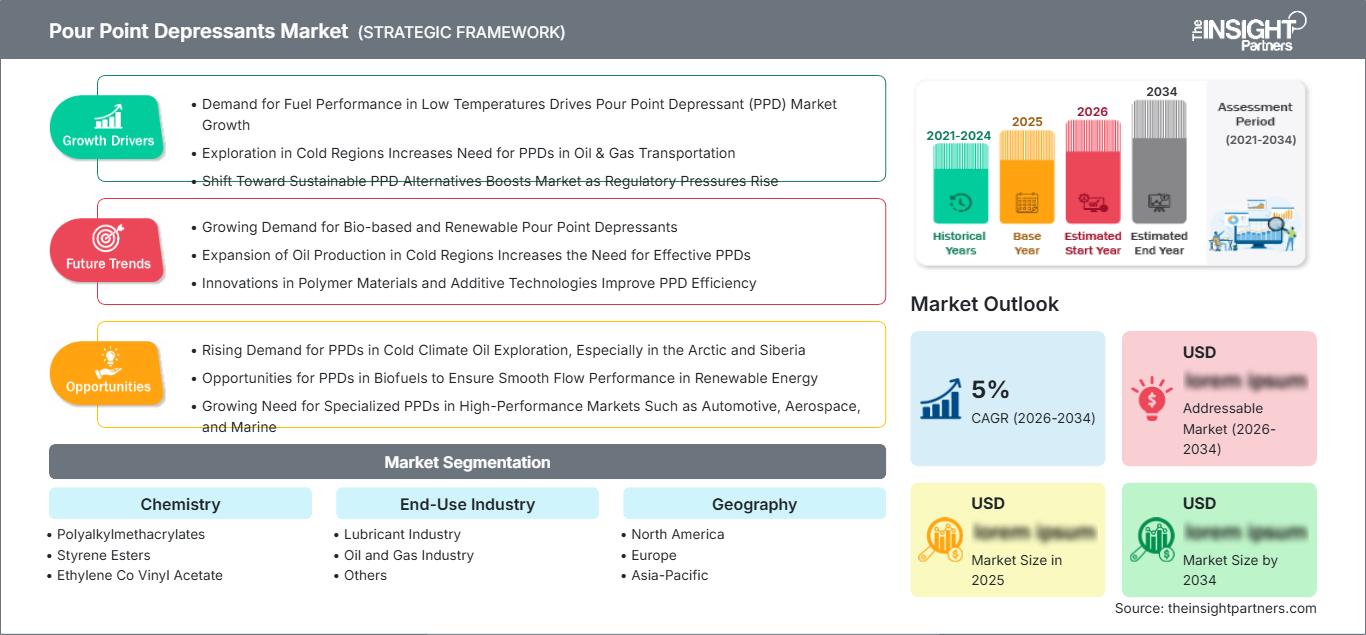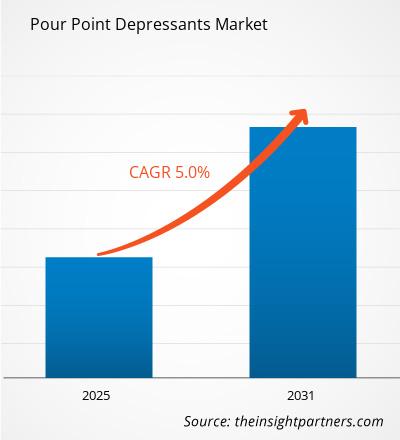Der Markt für Pourpoint-Erniedriger wird voraussichtlich von 2026 bis 2034 mit einer durchschnittlichen jährlichen Wachstumsrate (CAGR) von 5 % wachsen. Die Marktbedingungen entwickeln sich stetig weiter und eröffnen den Akteuren neue Chancen. Insgesamt zeichnet sich der Markt durch ein stabiles Wachstum und langfristiges Wachstumspotenzial ab.
Der Bericht ist nach chemischen Verbindungen (Polyalkylmethacrylate, Styrolester, Ethylen-Vinylacetat, Polyalphaolefin) gegliedert. Er enthält außerdem Analysen basierend auf den Endverbrauchsbranchen (Schmierstoffindustrie, Öl- und Gasindustrie, Sonstige). Die globale Analyse wird weiter auf regionaler Ebene und für wichtige Länder aufgeschlüsselt. Geografisch ist der Markt in Nordamerika, Europa, Asien-Pazifik, Naher Osten und Afrika sowie Süd- und Mittelamerika unterteilt. Der Bericht gibt den Wert der oben genannten Analysen und Segmente in US-Dollar an.
Zweck des Berichts
Der Bericht „Markt für Pour Point Depressants“ von The Insight Partners beschreibt die aktuelle Marktlage und das zukünftige Wachstum, die wichtigsten Triebkräfte, Herausforderungen und Chancen. Er bietet Einblicke für verschiedene Akteure im Markt, wie zum Beispiel:
- Technologieanbieter/Hersteller: Um die sich entwickelnde Marktdynamik zu verstehen und die potenziellen Wachstumschancen zu erkennen, damit sie fundierte strategische Entscheidungen treffen können.
- Investoren: Um eine umfassende Trendanalyse hinsichtlich der Marktwachstumsrate, der finanziellen Marktprognosen und der Chancen entlang der gesamten Wertschöpfungskette durchzuführen.
- Regulierungsbehörden: Zur Regulierung von Richtlinien und Überwachungstätigkeiten auf dem Markt mit dem Ziel, Missbrauch zu minimieren, das Vertrauen der Anleger zu erhalten und die Integrität und Stabilität des Marktes zu wahren.
Marktsegmentierung von Fließpunkterniedrigern (Chemie)
- Polyalkylmethacrylate
- Styrolester
- Ethylen-CoVinylacetat
- Poly-Alpha-Olefin
Endverbrauchsbranche
- Schmierstoffindustrie
- Öl- und Gasindustrie
- Andere
Sie erhalten eine kostenlose Anpassung aller Berichte – einschließlich Teilen dieses Berichts, Länderanalysen und Excel-Datenpaketen – sowie attraktive Angebote und Rabatte für Start-ups und Universitäten.
Markt für Stockpunkterniedriger: Strategische Einblicke

-
Ermitteln Sie die wichtigsten Markttrends dieses Berichts.Diese KOSTENLOSE Probe beinhaltet eine Datenanalyse, die von Markttrends bis hin zu Schätzungen und Prognosen reicht.
Wachstumstreiber des Marktes für Fließpunkterniedriger
- Nachfrage nach Kraftstoffen mit hoher Tieftemperaturleistung treibt das Marktwachstum für Fließverbesserer (PPD) an: Branchen wie die Automobil- und Schifffahrtsindustrie benötigen Kraftstoffe mit hoher Tieftemperaturleistung. Daher ist der Einsatz von Fließverbesserern (PPD) in verschiedenen Formulierungen unerlässlich, um die Wachsbildung zu begrenzen und die Fließfähigkeit zu verbessern. Dieser Bedarf an zuverlässiger Kraftstoffleistung bei niedrigen Temperaturen ist ein wesentlicher Faktor für das Marktwachstum.
- Exploration in kalten Regionen erhöht den Bedarf an Pourpoint-Erniedrigern im Öl- und Gastransport: Angesichts des aktuellen Trends bei der Exploration und Förderung von Öl und Gas in kalten Regionen wird die Verfügbarkeit von Pourpoint-Erniedrigern (PPDs) zunehmend an Bedeutung gewinnen. Diese Additive werden eingesetzt, um die Kristallisation von Wachs in Rohöl und seinen raffinierten Vorprodukten zu hemmen und so Transport und Verarbeitung bei niedrigen Temperaturen zu ermöglichen, was wiederum das Marktwachstum ankurbelt.
- Der Trend zu nachhaltigen PPD-Alternativen beflügelt den Markt angesichts steigenden Regulierungsdrucks: Aufgrund zunehmenden gesellschaftlichen Drucks und regulatorischer Maßnahmen geht der Trend weg von chemischen PPDs, die giftig und umweltschädlich sind. Diese nachhaltigen Alternativen gewinnen in Industrienationen, die sich auf die Reduzierung des CO₂-Fußabdrucks und die Einhaltung effektiver Umweltauflagen konzentrieren, zunehmend an Bedeutung und eröffnen damit neue Chancen auf dem PPD-Markt.
Markt für Fließpunktverbesserer – Zukunftstrends
- Steigende Nachfrage nach biobasierten und erneuerbaren Stockpunktverbesserern: Angesichts des wachsenden Bewusstseins für ökologische Nachhaltigkeit ist eine deutliche Verlagerung der Präferenz hin zu biobasierten und erneuerbaren Stockpunktverbesserern zu beobachten. Diese Additive werden aktuell entwickelt, um Emissionen zu reduzieren und die strengeren Auflagen auf den Märkten für Kraftstoffe und Schmierstoffe zu erfüllen.
-
Die Ausweitung der Ölförderung in kalten Regionen erhöht den Bedarf an effektiven Pourpoint-Erniedrigern (PPDs):
Ihre Effizienz ist jedoch deutlich höher, da Rohöl zunehmend bei niedrigeren Temperaturen gefördert wird, insbesondere in der Arktis oder bei der Offshore-Feldentwicklung. Daher wächst der Markt für Pourpoint-Erniedriger. Diese Modifikatoren erleichtern die Fließfähigkeit des Rohöls unter widrigen Bedingungen und sind daher in diesen geografischen Gebieten von großer Bedeutung. - Innovationen bei Polymerwerkstoffen und Additivtechnologien verbessern die Wirksamkeit von Fließpunkterniedrigern: Die Formulierung von Fließpunkterniedrigern wurde deutlich verbessert, was ihre Effektivität steigert. Innovationen bei Polymerwerkstoffen und Additivtechnologien ermöglichen eine hohe Effizienz bereits bei sehr geringen Fließpunkterniedrigeren Konzentrationen im Vergleich zu den zuvor verwendeten höheren Konzentrationen. Dies hat die Anwendung dieser Technologie in verschiedenen Kraftstoff- und Schmierstoffanwendungen beschleunigt.
Marktchancen für Fließpunktverbesserer
- Steigende Nachfrage nach Pourpoint-Erniedrigern (PPDs) bei der Erdölförderung in kalten Klimazonen, insbesondere in der Arktis und Sibirien: Mit der zunehmenden Ausweitung der Erdölförderung auf kalte Regionen wie die Arktis und Sibirien wird der Einsatz von Pourpoint-Erniedrigern (PPDs) stetig zunehmen. In diesen Gebieten ist der Einsatz von Additiven erforderlich, um den Transport von Rohöl zu erleichtern, was ein großes Wachstumspotenzial birgt.
- Einsatzmöglichkeiten von Fließverbesserern in Biokraftstoffen zur Sicherstellung optimaler Fließeigenschaften: Mit dem zunehmenden Fokus auf Biokraftstoffe und andere erneuerbare Energiequellen ergeben sich Anwendungsmöglichkeiten für Fließverbesserer in Biokraftstoffen. Fließverbesserer werden eingesetzt, um die Fließeigenschaften von Biodiesel und anderen erneuerbaren Kraftstoffen zu verbessern, die zur Deckung des Bedarfs an sauberer Energie benötigt werden.
- Steigender Bedarf an Spezial-Fließpunkterniedrigern in Hochleistungsmärkten wie der Automobil-, Luft- und Raumfahrt- sowie der Schifffahrtsindustrie: In Branchen wie der Automobil-, Luft- und Raumfahrt- sowie der Schifffahrtsindustrie besteht ein ungedeckter Bedarf an solchen Spezial-Fließpunkterniedrigern. Insbesondere die Förderung des Einsatzes maßgeschneiderter Fließpunkterniedriger-Formulierungen, die unter extremen Bedingungen eine bessere Leistung erbringen, wird zu einem Anstieg der Nachfrage führen, insbesondere bei Schmierstoffen und Kraftstoffen für Hochleistungsmärkte.
Markt für Pour-Point-Depressiva – Regionale Einblicke
Die regionalen Trends und Einflussfaktoren auf den Markt für Pourpoint-Erniedriger im gesamten Prognosezeitraum wurden von den Analysten von The Insight Partners eingehend erläutert. Dieser Abschnitt behandelt außerdem die Marktsegmente und die geografische Verteilung des Marktes für Pourpoint-Erniedriger in Nordamerika, Europa, Asien-Pazifik, dem Nahen Osten und Afrika sowie Süd- und Mittelamerika.
Berichtsumfang zum Markt für Fließpunkterniedriger
| Berichtattribute | Details |
|---|---|
| Marktgröße im Jahr 2025 | XX Millionen US-Dollar |
| Marktgröße bis 2034 | XX Millionen US-Dollar |
| Globale durchschnittliche jährliche Wachstumsrate (2026 - 2034) | 5% |
| Historische Daten | 2021-2024 |
| Prognosezeitraum | 2026–2034 |
| Abgedeckte Segmente |
Durch Chemie
|
| Abgedeckte Regionen und Länder |
Nordamerika
|
| Marktführer und wichtige Unternehmensprofile |
|
Marktdichte der Akteure im Markt für Fließpunkterniedriger: Auswirkungen auf die Geschäftsdynamik verstehen
Der Markt für Pourpoint-Erniedriger wächst rasant, angetrieben durch die steigende Nachfrage der Endverbraucher. Gründe hierfür sind unter anderem sich wandelnde Verbraucherpräferenzen, technologische Fortschritte und ein wachsendes Bewusstsein für die Vorteile des Produkts. Mit steigender Nachfrage erweitern Unternehmen ihr Angebot, entwickeln innovative Lösungen, um den Verbraucherbedürfnissen gerecht zu werden, und nutzen neue Trends, was das Marktwachstum zusätzlich beflügelt.

- Verschaffen Sie sich einen Überblick über die wichtigsten Akteure auf dem Markt für Pour Point Depressiva.
Wichtigste Verkaufsargumente
- Umfassende Abdeckung: Der Bericht bietet eine umfassende Analyse der Produkte, Dienstleistungen, Typen und Endnutzer des Marktes für Pour Point Depressiva und vermittelt so ein ganzheitliches Bild.
- Expertenanalyse: Der Bericht basiert auf dem fundierten Wissen von Branchenexperten und Analysten.
- Aktuelle Informationen: Der Bericht gewährleistet Geschäftsrelevanz durch die Berücksichtigung aktueller Informationen und Datentrends.
- Anpassungsmöglichkeiten: Dieser Bericht kann an die spezifischen Anforderungen des Kunden angepasst werden und sich optimal in die Geschäftsstrategien einfügen.
Der Forschungsbericht zum Markt für Pourpoint-Erniedriger kann daher maßgeblich dazu beitragen, das Branchenszenario und die Wachstumsaussichten zu entschlüsseln und zu verstehen. Auch wenn einige berechtigte Bedenken bestehen, überwiegen die Vorteile dieses Berichts insgesamt die Nachteile.
- Historische Analyse (2 Jahre), Basisjahr, Prognose (7 Jahre) mit CAGR
- PEST- und SWOT-Analyse
- Marktgröße Wert/Volumen – Global, Regional, Land
- Branchen- und Wettbewerbslandschaft
- Excel-Datensatz
Aktuelle Berichte
Erfahrungsberichte
Grund zum Kauf
- Fundierte Entscheidungsfindung
- Marktdynamik verstehen
- Wettbewerbsanalyse
- Kundeneinblicke
- Marktprognosen
- Risikominimierung
- Strategische Planung
- Investitionsbegründung
- Identifizierung neuer Märkte
- Verbesserung von Marketingstrategien
- Steigerung der Betriebseffizienz
- Anpassung an regulatorische Trends






















 Kostenlose Probe anfordern für - Markt für Pourpoint-Depressiva
Kostenlose Probe anfordern für - Markt für Pourpoint-Depressiva